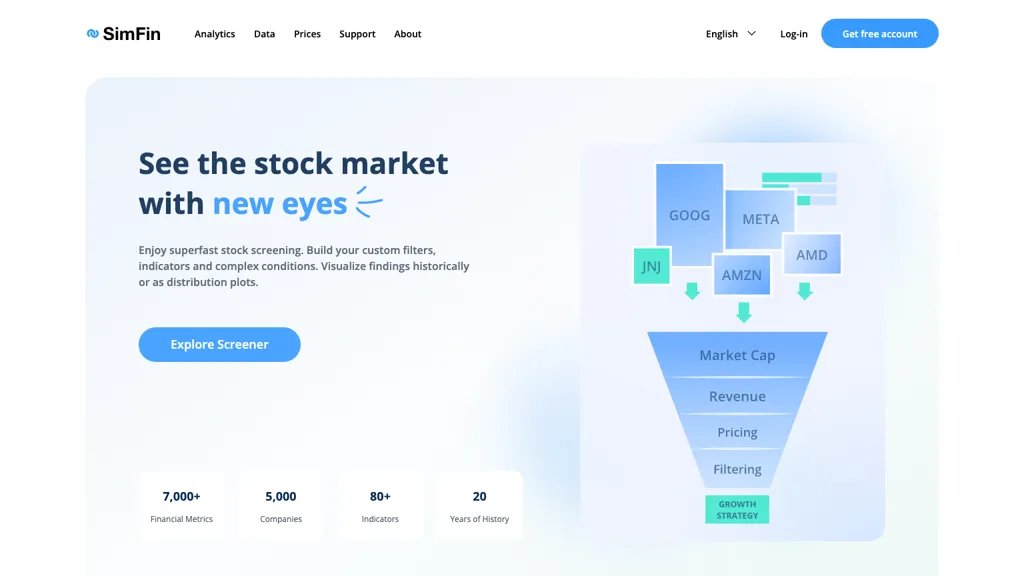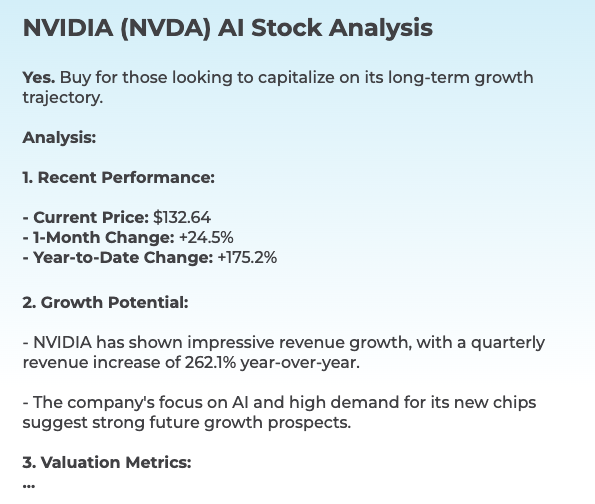20 Recommended Reasons On Choosing AI Stock Investing Analysis Websites
20 Recommended Reasons On Choosing AI Stock Investing Analysis Websites
Blog Article
Top 10 Tips For Evaluating Market Coverage Using Ai Stock Predicting/Analyzing Trading Platforms
When you are evaluating AI trading platforms that forecast or analyze stocks, market coverage is a key aspect to think about. It determines which assets and markets are readily available. A platform that has comprehensive market coverage allows you to diversify portfolios and discover global trading opportunities and adapt to different strategies. These are the 10 best ways to evaluate the market coverage offered by these platforms.
1. Evaluate Supported Asset Classes
Stocks: Make sure the platform includes major stock exchanges (e.g., NYSE, NASDAQ, LSE, HKEX) and includes small-cap, mid-cap, and large-cap stocks.
ETFs Make sure the platform lets you choose from a large number of ETFs, which will give you diversified exposure.
Options and futures: Verify if the platform covers derivatives such as options, futures and other instruments that leverage.
Forex and commodities. See whether there are any forex pairs that are available, in addition to precious metals, commodities for energy and agricultural commodities.
Cryptocurrencies. Check if it supports the major altcoins and cryptocurrencies (e.g. Bitcoin, Ethereum).
2. Make sure you check the area of coverage
Global markets. Make sure your platform is able to cover the major global market that includes North America Europe Asia-Pacific and emerging countries.
Regional focus: Verify if the platform specializes in specific markets or regions that align with your interests in trading.
Local exchanges - Examine to find out if there are local or regional exchanges available that relate to your location and your strategy.
3. Comparing Real-Time Data to Delayed Data Data that is delayed
Real-time Market Data: The system must offer real-time trading information that allows for quick decision-making.
Delayed Data: Check whether the delayed data could be obtained for free or at an affordable cost. They could be enough for long term investors.
Data latency: Check whether the platform reduces latency in real-time feeds of data, particularly in high-frequency trading.
4. Assess Historical Data Availability
Historical data depth Make sure the platform provides extensive historical data (e.g. 10, more than 10 years) to backtest and analyze.
Granularity: Find out if the data includes intraday, daily weekly, monthly and intraday granularity.
Corporate actions: Check if the historical information includes stock splits and dividends.
5. Review for market depth and order information
For better price discovery, ensure that the platform includes Level 2 data.
Verify the bid-ask ranges in order to make sure you are getting the most accurate price.
Volume data: Ensure that the platform has detailed data on volume for analysing liquidity and market activities.
6. Examine the coverage of Indices and Sectors
Major indices: Check that the platform supports major indexes (e.g., S&P 500, NASDAQ 100, FTSE 100) for benchmarking and index-based strategies.
Information from specific industries: To perform a specific analysis, determine if the platform has data for certain sectors (e.g. health care, technology, etc.).
Custom indices. Find out if you are able to make or track custom indices according to your criteria.
7. Test the Integration of News and Sentiment Data
News feeds - Make sure the platform is integrating real-time news feeds for market-moving stories from reputable (e.g. Bloomberg or Reuters) sources.
Sentiment analysis: Find out if there are tools for sentiment analysis that are based on news articles, or other data sources.
Event-driven Strategies: Check if the platform supports strategies that are driven by events (e.g. economic reports and earnings announcements).
8. Check for Multi-Market Trading Capabilities
Cross-market trading : Ensure that the platform supports trading on different markets, asset classes and exchanges from a single interface.
Verify that the platform supports multicurrency accounts and currency conversions to facilitate international trading.
Time zone support: Check if the platform accommodates trading in various time zones to facilitate global markets.
9. Assess Coverage of Alternative Data Sources
Alternate data sources: To gain new insights, make sure that the platform incorporates other sources of data.
ESG data: Determine whether the platform is equipped with environmental, social and governance (ESG), or other data that can aid in socially responsible investment.
Macroeconomics data: for a more fundamental analysis, ensure the platform contains macroeconomic indicators like GDP (gross domestic product) inflation rates, GDP and interest rate.
10. Review Market Feedback and User Reviews. Reputation
User reviews: Search for reviews from users to gain a better understanding of the platform.
Reputation in the industry: Find out whether the platform is regarded for its market coverage by experts in the industry or by awards.
Case studies: Search for cases studies or testimonials that highlight the platform's performance in particular markets or asset classes.
Bonus Tips
Trial period: You may try the demo, trial, or free trial to check the coverage of markets and the data quality.
API access: Make sure the API on the platform allows you to programmatically access market data for custom analysis.
Customer Support: Ensure that the platform can provide support for any data-related or market-related problems.
By following these tips to evaluate the market coverage of AI trading platforms that predict or analyze stocks and ensure that you select the one that gives you access to the market and the information you need for a successful trading. A broad market coverage can let you diversify, investigate, and adapt your portfolio to new market conditions. Take a look at the best sources tell me for ai investment platform for site advice including options ai, ai for stock trading, ai for stock trading, ai trading, ai for stock trading, ai investing, ai investing app, best ai stock, market ai, ai stock trading app and more.
Top 10 Tips To Assess The Updating And Maintenance Of Ai Stock Predicting Trading Platforms
Examining the maintenance and updates of AI-driven stock prediction and trading platforms is crucial to ensure that they are secure, efficient and in line with changing market conditions. Here are 10 suggestions on how you can evaluate the maintenance and update procedures:
1. Updates will be made frequently
You can check the frequency with which updates are released (e.g., every week, each month, or every quarter).
Why: Regular updates indicate an active and flexible development, as well as a willingness to respond to market changes.
2. Transparency in Release notes
Check out the release notes for your platform to find out what improvements and modifications were implemented.
Why? Transparent Release Notes show the platform's commitment to continuous improvement.
3. AI Model Retraining Schedule
Tip: Ask when the AI models are refreshed using new data.
Reasons: Models have to change to stay accurate and relevant as markets shift.
4. Correction of bugs and issues
TIP: Evaluate how fast the platform can address bugs or technical issues reported by users.
Why: Quick bug fixes can ensure the platform's reliability and functionality.
5. Updates to Security
Tip: Verify if the platform regularly updates its security protocols to protect user data and trading activities.
The reason: Cybersecurity on financial platforms is crucial to guard against breaches and fraud.
6. Integration of New Features
Go through the platform to determine whether it has introduced new features that are based on user or market feedback (e.g., enhanced analytics).
What's the reason? Features updates show innovation, responsiveness to the needs of users and creativity.
7. Backward Compatibility
Tip : Make sure that any updates don't interfere with existing functionality or require major configuration.
Why is this: Backwards compatibility allows for users with a smooth experience during transitions.
8. Communication between Maintenance Workers
Learn how your platform informs users about scheduled maintenance or downtime.
What is the reason? Clear communication creates trust and minimizes disruptions.
9. Performance Monitoring and Optimization
Tips - Make sure that the platform is constantly monitoring the performance metrics (e.g. latency, accuracy) and optimizes systems.
Why: Continuous optimization is essential to ensure that the platform remains efficient.
10. Compliance with Regulatory Changes
Find out if the platform changed its policies and features in order to be compliant with any new data legislation or regulations regarding financial transactions.
The reason: Compliance with regulatory requirements is vital to preserve user confidence and avoid legal risks.
Bonus Tip: Integration of user feedback
Check that the platform is taking feedback from users into maintenance and updates. This shows a user-centric approach and dedication to continuous improvement.
By evaluating all of these factors, it is possible to make sure you are sure that the AI stock trading system you select has been maintained properly. It must also be up-to-date and adaptable to the changing dynamics of markets. Take a look at the top extra resources on ai trading tool for site examples including ai share trading, ai stock investing, can ai predict stock market, ai stock analysis, ai for trading stocks, chart analysis ai, best ai stocks, best ai stocks to buy now, how to use ai for copyright trading, ai tools for trading and more.